St. Helena, Ascension und Tristan da Cunha |
|
|
|
| Übersicht – Contents: | |
Diese Seite ist Teil des Projektes
St. Helena, Ascension und Tristan da Cunha |
|
|
|
| Übersicht – Contents: | |
Flaggen – Flags: |
|
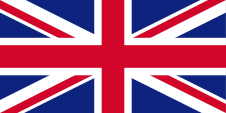 |
seit/since 1834, |
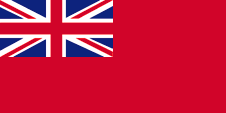 |
seit/since 1864, |
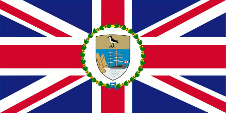 |
seit/since 1999, Flagge des Gouverneurs – flag of the Governor, Seitenverhältnis – ratio 1:2, Quelle/Source, nach/by: Wikipedia (EN), Flags of the World |
St. Helena – Saint Helena: |
|
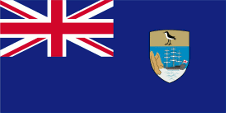 |
seit/since 2019, National- und Staatsflagge – national and state flag, Seitenverhältnis – ratio 1:2, Quelle/Source, nach/by: Wikipedia (EN), Flags of the World, Corel Draw 4    |
Tristan da Cunha: |
|
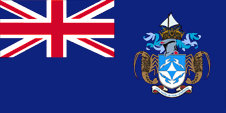 |
seit/since 2002, National- und Staatsflagge – national and state flag, Seitenverhältnis – ratio 1:2, Quelle/Source, nach/by: Wikipedia (EN), Flags of the World |
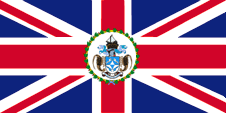 |
seit/since 1999, Flagge des Administrators – flag of the Administrator, Seitenverhältnis – ratio 1:2, Quelle/Source, nach/by: Wikipedia (EN), Flags of the World |
Ascension: |
|
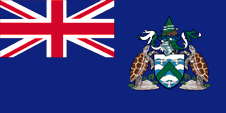 |
seit/since 2013, National- und Staatsflagge – national and state flag, Seitenverhältnis – ratio 1:2, Quelle/Source, nach/by: Flags of the World |
historische Flaggen – historical Flags: |
|
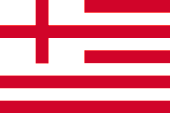 |
ca. 1659–1707, |
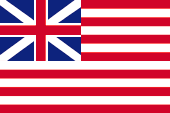 |
1707–1801, |
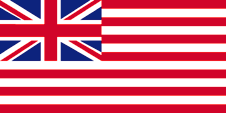 |
1801–1833, |
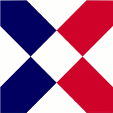 |
ca. 1811, Tristan da Cunha, inoffizielle Flagge – unofficial flag, Seitenverhältnis – ratio 1:1, Quelle/Source, nach/by: Flags of the World |
 |
1874–1984, St. Helena, Flagge der Regierung (Staatsflagge) – flag of the government (state flag), Seitenverhältnis – ratio 1:2, Quelle/Source, nach/by: Flags of the World, Corel Draw 4 |
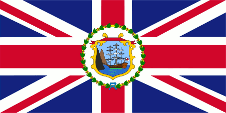 |
1944–1984, St. Helena, Flagge des Gouverneurs – flag of the Governor, Seitenverhältnis – ratio 1:2, Quelle/Source, nach/by: Wikipedia (EN), Flags of the World |
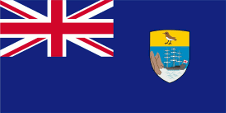 |
1984–2019, St. Helena, National- und Staatsflagge – national and state flag, Seitenverhältnis – ratio 1:2, Quelle/Source, nach/by: Flags of the World, Corel Draw 4 |
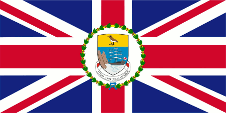 |
1984–1999, St. Helena, Flagge des Gouverneurs – flag of the Governor, Seitenverhältnis – ratio 1:2, Quelle/Source, nach/by: 1.) Flags of the World, 2.) Flags of the World |
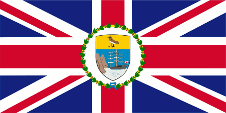 |
1999–2019, St. Helena, Flagge des Gouverneurs – flag of the Governor, Seitenverhältnis – ratio 1:2, Quelle/Source, nach/by: 1.) Flags of the World, 2.) Flags of the World |
|
St. Helena und seine
Dependenzen sind britische Außenbesitzungen. Ihre Flaggen unterliegen den
Regelungen des britischen Ensign-Systems. St. Helena und seine Dependenzen
wurden 1834 eine britische Kronkolonie, die Flagge Großbritanniens wurde
gehisst, die Inseln wurden Teil des United Kingdom, erhielten eine eigene
Verwaltung und einen eigenen Gouverneur. Ab diesem Zeitpunkt repräsentierten
der einzelne Bürger und auch die Behörden ihren Status als Bürger oder
Organe der britischen Nation, verkörpert im United Kingdom, durch die
Verwendung des Union Jack, dann "Union Flag" genannt. Zur See war für den
britischen Bürger ab 1864 die britische Handelsflagge, der Red Ensign (Rote
Flagge) vorgesehen. In einigen wenigen Fällen wurde den Bürgern einer
Kolonie durch die Admiralität erlaubt, auf See einen eigenen Red Ensign mit
dem Badge der Kolonie zu verwenden. Somit ist an Land die Unionsflagge die eigentliche National- und Staatsflagge. Auf St. Helena und seinen Dependenzen darf seit 1984 auch an Land der "Blue Ensign" (eigentl. Staatsflagge zur See) mit dem Abzeichen des Landes ebenfalls zu dekorativen Zwecken als Nationalflagge verwendet werden, wenn der Gouverneur das genehmigt hat, und zwar zeitlich begrenzt, z.B. bei einer Veranstaltung (auch außerhalb des Landes) oder auch zur Unterscheidung, wenn die Verwendung der Unionsflagge unangemessen wäre, oder geeignet wäre Verwirrung zu stiften. An Land soll das Seitenverhältnis der Flagge dann jedoch 3:5 betragen. Ein "Blue Ensign" ist ein dunkelblaues Flaggentuch mit einer Flaggendarstellung – dem britischen Union Jack – in der Oberecke und dem Abzeichen/Badge des Landes im wehenden Ende der Flagge, wobei der Union Jack auf die Verbindungen zu Großbritannien hinweist. Großbritannien hatte in Jahr 1864 ein Flaggensystem eingeführt, in dem: • Kriegsschiffe einen sogenannten "White Ensign" (Marineflagge), eine weiße Flagge oft mit durchgehendem roten Georgskreuz und mit dem Union Jack in der Oberecke, • Handelsschiffe einen "Red Ensign" (auch "Civil Ensign" → Bürgerflagge genannt, die eigentl. Handelsflagge), eine rote Flagge mit dem Union Jack in der Oberecke, und • Dienstschiffe einen "Blue Ensign" (Regierungsflagge → die eigentliche Staatsflagge), eine blaue Flagge mit dem Union Jack in der Oberecke führten. Seit 1865 durften Schiffe von Kolonialregierungen einen Blue Ensign mit einem Badge (Abzeichen) im fliegenden Ende führen. Die jeweiligen Regierungen sollten entsprechende Bagdes zur Verfügung stellen. Handelsschiffe und seefahrende Privatpersonen aus Kolonien dürfen nur dann einen Red Ensign mit Badge führen, wenn von der britischen Admiralität eine entsprechende Erlaubnis für die Kolonie erteilt wurde. Ein solches Badge war oft eine auf einer Scheibe platzierte regionale landschaftliche Darstellung, zeigte oft Schiffe, historische Begebenheiten oder konnte auch nur eine Art Logo sein. Sehr oft zeigte ein Badge zusätzlich den Namen des Landes oder auch einen Wahlspruch. Einige Besitzungen hatten aber auch schon von Anfang an ein Wappen, bzw. erhielten über die Jahre ein eigenes Wappen und das Badge wurde abgeschafft. Um ein weitgehend einheitliches Erscheinungsbild im fliegenden Ende der Flaggen zu gewährleisten, wurden Wappen und auch andere Symbole auf einer weißen Scheibe in der Größe der früheren Badges dargestellt. Es gab hier aber auch Ausnahmen, denn einige Kolonien verwendeten diese weiße Scheibe nicht, und platzierten ihr Wappen oder auch nur das Wappenschild - manchmal auch vergrößert - direkt auf das Flaggentuch. Schon in den 40-er Jahre wurde dazu übergegangen die weiße Scheibe zu entfernen und das Wappen direkt zu platzieren oder vergrößert dazustellen. Dieser Umstellungsprozess erfolgte allmählich, nirgendwo gleichzeitig und vollständig. In einigen britischen Besitzungen sind bis heute Flaggen mit der weißen Scheibe in Gebrauch, in anderen nicht mehr und in einigen Gebieten gibt es beide Varianten nebeneinander. Im Jahre 1874 wurde als Staatsflagge zur See ein eigener "Blue Ensign" eingeführt, ein dunkelblaues Flaggentuch mit einer Flaggendarstellung – dem britischen Union Jack – in der Oberecke (er weist auf die Verbindungen zu Großbritannien hin), der im wehenden Ende der Flagge das Badge zeigte. 1984 wurde das Badge auf der Flagge abgeschafft und durch den Schild des 1984 verliehenen Wappens ersetzt. Im Jahre 2019 wurde die Abbildung des Regenpfeifers mehr der Realität angepasst und das Goldgelb in Gold abgeändert. In den Jahren 2002 bzw. 2013 wurden auf den Dependenzen Tristan da Cunha und Ascension eigene "Blue Ensigns" als National- und Staatsflaggen für die Nutzung durch Bürger und Behörden eingeführt. Da St. Helena dem britischen Ensign- und Farbensystem folgt, entsprechen die Farben der Flagge dem Spektrum, welches das britische Verteidigungsministerium in seiner Publikation "Flags of all Nations" (eine Dienstvorschrift) für folgende Farben angibt: Blau = pt 180 c, Rot = pt 186 c. |
St. Helena and its
dependencies are British outlying possessions. Their flags are subject to
the regulations of the British Ensign system. St. Helena and its
Dependencies became a British Crown Colony in 1834, the flag of United
Kingdom was hoisted, the islands became part of the United Kingdom and were
given their own administration and governor. From this point in time onwards, individuals, citizens and also the authorities represented their status as citizens or organs of the British nation, embodied in the United Kingdom, through the use of the Union Jack, then called the "Union Flag". At sea, the British merchant flag, the Red Ensign, was intended for British citizens from 1864. In a few cases, the citizens of a colony were authorised by the Admiralty to use their own Red Ensign with the colony's badge at sea. The Union Flag is therefore the actual national and state flag on land. On St. Helena and its dependencies, the "Blue Ensign" (the actual state flag at sea) with the country's insignia may also be used as the national flag for decorative purposes since 1984, if the governor has authorised this, and for a limited period of time, e.g. at an event (also outside the country) or also for differentiation, if the use of the Union flag would be inappropriate or could cause confusion. On land, however, the aspect ratio of the flag should be 3:5. A "Blue Ensign" is a dark blue bunting with a flag representation – the British Union Jack – in the upper corner and the country's badge in the flying end of the flag, with the Union Jack indicating the links to United Kingdom. United Kingdom introduced a flag system in 1864 in which: • war ships fly the "White Ensign" (naval flag), a white flag often with an uninterrupted red St. George's-Cross and with the Union Jack in the upper staff quadrant of the flag, • merchant ships fly a "Red Ensign" (also named "Civil Ensign" → civil flag, the real merchant flag), a red flag with the Union Jack in the upper staff quadrant of the flag, and • governmental ships fly the "Blue Ensign" (flag for the use by the gouvernment → the actual state flag), a blue flag with the Union Jack in the upper staff quadrant of the flag. From 1865, the ships of the colonial governments were allowed to use a Blue Ensign with a badge at the flying end. The respective governments were to provide appropriate badges. Merchant ships and seafaring privateers from colonies were only allowed to use a Red Ensign with a badge if the British Admiralty had issued a corresponding licence for that colony. Such a badge was often a regional landscape depiction on a disc, often showed ships, historical events or could simply be a kind of logo. Very often a badge also contained the name of the country or a motto. However, some possessions had a coat of arms from the beginning or were given their own coat of arms over the years and the badge was abolished. To ensure a largely uniform appearance in the flying end of the flags, coats of arms and other symbols were displayed on a white disc in the size of the former badges. However, there were also exceptions, as some colonies dispensed with this white disc and placed their coat of arms or even just the shield – sometimes enlarged – directly on the bunting. As early as the 1940s, the white disc was removed and the coat of arms was applied directly or enlarged. This conversion process took place gradually, nowhere simultaneously and completely. In some British possessions flags with the white disc are still in use today, in others no longer and in some areas both variants exist side by side. In 1874, an own "Blue Ensign" was introduced as the state flag at sea, a dark blue bunting with a flag depiction – the British Union Jack – in the upper corner (indicating the links to United Kingdom), which showed the badge in the flying end of the flag. In 1984, the badge on the flag was abolished and was replaced by the escutcheon of the coat of arms awarded in 1984. In 2019, the depiction of the plover was adapted more to reality and the golden yellow was changed to gold. In 2002 and 2013, the Tristan da Cunha and Ascension Dependencies introduced their own "Blue Ensigns" as national and state flags for use by citizens and authorities. As St. Helena follows the British ensign and colour system, the colours of the flag correspond to the spectrum specified by the British Ministry of Defence in its publication "Flags of all Nations" (a service regulation) for the following colours: Blue = pt 180 c, Red = pt 186 c. |
| Quelle/Source: Die Welt der Flaggen, Wikipedia (EN), Flags of the World, Volker Preuß | |
Wappen – Coat of Arms: |
|
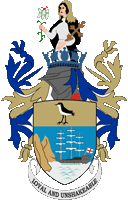 |
seit/since 2019, Wappen von St. Helena – coat of arms of Saint Helena, Quelle/Source, nach/by: Corel Draw 4, sainthelena.gov.sh |
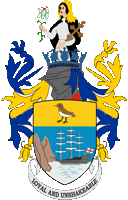 |
1984–2019, Wappen von St. Helena – coat of arms of Saint Helena, Quelle/Source, nach/by: Corel Draw 4 |
 |
seit/since 2019, Bagde (Abzeichen) von St. Helena – Bagde of Saint Helena, Quelle/Source, nach/by: Wikipedia (EN) |
 |
1984–2019, Bagde (Abzeichen) von St. Helena – Bagde of Saint Helena, Quelle/Source, nach/by: Corel Draw 4, Flags of the World |
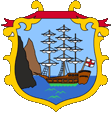 |
1874–1984, Bagde (Abzeichen) von St. Helena – Bagde of Saint Helena, Quelle/Source, nach/by: Flags of the World |
| Das heutige Wappen von St. Helena wurde am 30.01.1984 eingeführt. Es zeigt einen Wappenschild mit einem Dreimaster mit gerefften Segeln und einer englischen Flagge am Heck am Fuß hoher, steiler Klippen. Die Szene gilt als ein Sinnbild für die Inbesitznahme durch die Englische Ostindische Kompagnie im Jahre 1659. Im Schildhaupt ein goldenes Feld mit einem Regenpfeifer, der die hiesige Fauna repräsentieren soll. Links und rechts des Schildes goldene und blaue Decken. Oberhalb des Schildes ein Helm mit einer eisernen Krone aus Wappenschilden und Segeln. Oberhalb der Krone die Heilige Helena mit dem Kreuz. Sie hält eine Blume in der Hand. Unterhalb des Wappenschildes ein Spruchband mit dem Motto der Kolonie: "Loyal and unshakeable" → "Treu und unerschütterlich". Anstelle des kompletten Wappens wird auf der blauen Dienstflagge nur der Wappenschild als Badge (Abzeichen) gezeigt. Vorlage für das erste Badge von Helena aus dem Jahre 1874 war das bis dato verwendete Siegel der Insel, inklusive Bild, verzierendem Rahmen und schmückendem Tuch an der Oberkante. Das Bild zeigte – wie auf dem heutigen Wappen – einen Dreimaster mit gerefften Segeln und einer englischen Flagge am Heck am Fuß hoher, steiler Klippen. Auf derartige Landschaftsszenen wurde in vielen britischen Kolonien zurückgegriffen. Im Jahre 1984 wurde das Wappen für St. Helena und Dependenzen eigeführt. Jedoch wurde nicht das komplette Wappen auf dem Blue Ensign übertragen, sondern nur der Schild des Wappens wurde als Badge verwendet. Im Jahre 2019 wurde die Abbildung des Regenpfeifers mehr der Realität angepasst und das Goldgelb in Gold abgeändert. |
The today's coat of arms
of Saint Helena was introduced on 30th of January in 1984. It shows an
escutcheon with a three-master with reefed sails and an English flag at the
stern at the foot of high, steep cliffs. The scene is considered a symbol of
the taking possession by the English East India Company in 1659. In the head of the shield there is a golden field with a plover, which is supposed to represent the local fauna. Gold and blue blankets appear to the left and right of the shield. Above the shield is a helmet with an iron crown made of heraldic shields and sails. Above the crown appears Saint Helena with the cross. She is holding a flower in her hand. Below the coat of arms there is a banner with the colony's motto: "Loyal and unshakeable". Instead of the complete coat of arms, only the escutcheon is shown as a badge on the blue governmental flag. The template for Helena's first badge from 1874 was the island's previously used seal, including a picture, decorative frame and decorative cloth on the top edge. The picture showed – like on today's coat of arms – a three-master with reefed sails and an English flag at the stern at the foot of high, steep cliffs. Such landscape scenes were used in many British colonies. In 1984 the coat of arms for Saint Helena and Dependencies was introduced. However, not the entire coat of arms was transferred to the Blue Ensign, but only the shield of the coat of arms was used as a badge. In 2019, the image of the plover was adapted more to reality and the golden yellow was changed to gold. |
| Quelle/Source: Die Welt der Flaggen, Wikipedia (EN), Flags of the World, Volker Preuß | |
Landkarte – Map: |
Lage – Position: |
Landkarte des Landes – Map of the Country: |
|
|
| Zahlen und Fakten – Numbers and Facts: | |
|
|
|
|
|
|
|
|
|
|
|
|
|
|
|
|
|
|
St. Helena:
21.05.1502
· der portugiesische Seefahrer João da Nova entdeckt die unbewohnte Insel,
er benennt sie nach der Heiligen Helena, die Insel wird besetzt und eine
Kirche errichtet
1501
· portugiesische Seefahrer entdecken die unbewohnte Insel Ascension
1506
· der portugiesische Seefahrer Tristan da Cunha entdeckt die unbewohnte
Insel, sie erhält seinen Namen
1652
· niederländische Seefahrer entdecken die unbewohnte Insel 20 Kilometer
nordwestlich der heutigen Insel Nightingale, landen unter großen
Schwierigkeiten, können jedoch nicht ins Landesinnere vordringen, daher
nennen sie die Insel "Inaccessible" (die Unerreichbare)
1506
· der portugiesische Seefahrer Tristan da Cunha entdeckt die unbewohnte
Insel 30 Kilometer südwestlich der Insel Tristan da Cunha, die Lage Insel
gerät jedoch in Vergessenheit
1506
· der portugiesische Seefahrer Diego Gonçalo Alvarez entdeckt die unbewohnte
Insel 400 km südöstlich der Insel Tristan da Cunha und gibt ihr seinen Namen
(Diego Alvarez), die Lage Insel gerät jedoch in Vergessenheit |
Saint Helena:
21st of May 1502 · the Portugese seafarer João da Nova discovers
the uninhabited island, he names it by the Saint Helena, the island becomes
occupied and they built a church
1501
· Portugese seafarers discover the uninhabited Ascension Island
1506
· the Portugese seafarer Tristan da Cunha discovers the uninhabited island,
it gets its name
1652
· Dutch seafarers discover the uninhabited island 12,5 miles northwestern of
today’s Nightingale Island, they debark under big difficulties but it is not
possible to reach the interior, because of that they name the island
"Inaccessible"
1506
· the Portugese seafarer Tristan da Cunha discovers the uninhabited island
19 miles southwestern Tristan da Cunha Island, but the position of the
island falls into oblivion
1506
· the Portugese seafarer Diego Gonçalo Alvarez discovers the uninhabited
island 250 miles southeastern of Tristan da Cunha Island and gives it his
name (Diego Alvarez), but the position of the island falls into oblivion |
| Quelle/Source: Atlas zur Geschichte, World Statesmen, Wikipedia (EN), Volker Preuß |
| Der Name der Insel "St. Helena" geht auf den Tag der Entdeckung dieser Insel durch João da Nova zurück. Es war der Namenstag der Heiligen Helena. Helena (ca. 255–ca.330) war die Mutter Kaiser Konstantins des Großen. Sie baute zusammen mit ihrem Sohn Kirchen in Rom und in Heiligen Land. Eine Legende erzählt über ihr Mitwirken bei der Auffindung des Kreuzes von Jesus Christus. | The name of the island "Saint Helena" goes back to the day of the discovery of this island by João da Nova. It was the name day of Saint Helena. Helena (ca. 255–ca.330) was the mother of Emperor Constantin the Great. She build together with her son churches in Rome and in the Holy Land. A legend tells us above her playing a part in the find of the cross of Jesus Christ. |
| Der Name der Insel "Ascension" geht auf den Tag ihrer Entdeckung zurück. Es war der Tag von Christi Himmelfahrt (Ascensus). | The name of the island "Ascension" goes back to the day of its discovery. It was the day of the Ascension of Christ (Ascensus). |
| Der Name der Insel "Tristan da Cunha" ist der Name ihres Entdeckers (im Jahre 1506), eines portugiesischen Seefahrers. | The name of the island "Tristan da Cunha" is the name of its discoverer (in the year 1506), a Portugese seafarer. |
| Der Name der Insel "Inaccessible" geht auf ihre Entdeckung im Jahre 1652 zurück. Es war damals unmöglich ins Landesinnere zu gelangen. Sie wurde "die Unerreichbare" genannt. | The name of the island "Inaccessible" goes back to the day of its discovery in the year 1652. It was at that time not possible to reach the interior. It was named "the Inaccessible". |
| Der Name der Insel "Nightingale" ist der Name eines britischen Forschers, der die Insel im Jahre 1760 erforschte. | The name of the island "Nightingale" is the name of a British explorer who explored the island in the year 1760. |
| Der Name der Insel "Gough" ist der Name ihres Wiederentdeckers, des Kapitäns Gough, der die Insel im Jahre 1731 wieder entdeckte, nachdem ihre Lage seit ihrer Entdeckung im Jahre 1506 in Vergessenheit geraten war. | The name of the island "Gough" is the name of its re-discoverer, of captain Gough, who discovered the island again in the year 1731, after its position fell into oblivion since its discovery in the year 1506. |
| Quelle/Source: World Statesmen, Wikipedia (EN), Volker Preuß | |